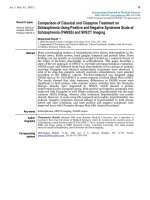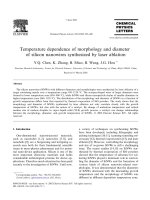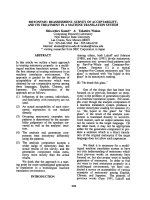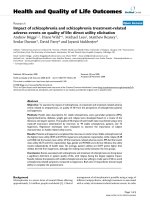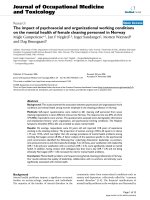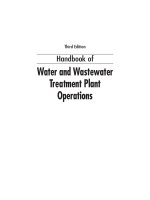Morpholpgy dependence of hybrid nanofibers incoorporated with nanoparticles of electrospinning and post treatment conditions
Bạn đang xem bản rút gọn của tài liệu. Xem và tải ngay bản đầy đủ của tài liệu tại đây (1.12 MB, 68 trang )
MORPHOLOGY DEPENDENCE OF HYBRID
NANOFIBERS INCOORPORATED WITH
NANOPARTICLES ON ELECTROSPINNING AND
POST-TREATMENT CONDITIONS
LIU YINGJUN
NATIONAL UNIVERSITY OF SINGAPORE
2008
MORPHOLOGY DEPENDENCE OF HYBRID
NANOFIBERS INCOORPORATED WITH
NANOPARTICLES ON ELECTROSPINNING AND
POST-TREATMENT CONDITIONS
LIU YINGJUN
(B. Sci. (Hons.), Fudan University)
A THESIS SUBMITTED
FOR THE DEGREE OF MASTER OF ENGINEERING
DEPARTMENT OF MECHANICAL ENGINEERING
NATIONAL UNIVERSITY OF SINGAPORE
2008
Acknowledgements
I would like to acknowledge and express his utmost gratitude to my graduate
supervisor, Professor Seeram Ramakrishna, whose ideas and support made my
time as a graduate student one of the most rewarding experiences I have ever had.
Without him, the idea for this unique research may have never come up.
I want to especially express my gratitude to Dr. Rajendrakumar Suresh Barhate,
whose never-ending enthusiasm, support, stories and good patience were the
reason I enjoyed both in lab and during tea time.
Thank you to Mr. Abhishek Kumar, Ramakrishna Ramaseshan, and Dong Yixiang,
who provided the insights, ideas and criticisms when we worked together in a
team. With them, I spent the most fruitful and joyful time of the past years.
Especial thanks to Rama for his painstaking effort on correcting my thesis.
Thank you to the entire Nanobioengineering Laboratory who created a warm and
family-like atmosphere in the cool lab.
I have special gratitude for my parents, who have always supported me and
provided me with the two best role models I could ever have. The author also
thank to my wife, the gift of life.
ii
Table of Contents
Acknowledgements ....................................................................................................................ii
Table of Contents ..................................................................................................................... iii
Summary ....................................................................................................................................v
List of Figures ...........................................................................................................................vi
List of Tables ............................................................................................................................vii
List of Abbreviations.............................................................................................................. viii
Chapter 1 General Introduction..................................................................................................1
1.1 Motivation ....................................................................................................................1
1.2 Thesis organization.......................................................................................................2
Chapter 2 Related Works............................................................................................................3
2.1 A brief history of electrospinning and electrospraying.................................................3
2.2 Working medium ..........................................................................................................6
2.3 Bead-fiber transition.....................................................................................................6
2.3.1 Instabilities ........................................................................................................7
2.3.2 Chain entanglements .........................................................................................7
2.4 Evaporation ..................................................................................................................9
Chapter 3 Bead-fiber Transition on Nanofibers Morphology ..................................................12
3.1 Introduction ................................................................................................................12
3.2. Experimental section .................................................................................................14
3.2.1 Materials and measurement.............................................................................14
3.2.2 Electrospinning................................................................................................15
3.3 Results ........................................................................................................................16
3.3.1 Concentration effects on bead-fiber transition ................................................16
3.3.2 Molecular weight effects on bead-fiber transition...........................................18
3.3.3 Applied voltage effects on bead-fiber transition..............................................18
3.3.4 Anionic surfactant (PDDPPDT) effects on bead-fiber transition ....................19
3.4 Discussion ..................................................................................................................22
3.4.1 Rayleigh instability..........................................................................................22
3.4.2 Competition between Rayleigh instability and elastic response......................23
3.4.3 Origin of the elastic response: chain entanglements........................................26
Chapter 4 Morphology Dependence of Nanofiber on Evaporation..........................................29
4.1 Introduction ................................................................................................................29
4.2. Experimental section .................................................................................................30
4.2.1 Materials and measurement.............................................................................30
4.2.2 Electrospinning................................................................................................30
4.3 Modeling of skin formation........................................................................................31
4.3.1 Transport of solvent outside skin.....................................................................31
4.3.2 Transport of solvent inside skin.......................................................................32
4.3.3 Skin thickness..................................................................................................32
4.4 Results and discussion................................................................................................33
4.4.1 Results .............................................................................................................33
iii
4.4.2 Skin formation during evaporation..................................................................34
4.4.3 Other effects during evaporation .....................................................................36
Chapter 5 Bead Growth on Nanofiber Induced by Surfactant..................................................38
5.1 Introduction ................................................................................................................38
5.2. Experimental section .................................................................................................39
5.2.1. Materials and measurement............................................................................39
5.2.2 Electrospinning................................................................................................39
5.2.3 Sorption ...........................................................................................................39
5.3 Modeling of growth of bead.......................................................................................40
5.4 Results and discussion................................................................................................41
5.4.1 Results .............................................................................................................41
5.4.2 Relaxation mechanism of bead growth ...........................................................42
5.4.3 Further simplification ......................................................................................44
Chapter 6 Conclusions and Future Works ................................................................................48
6.1 Conclusions ................................................................................................................48
6.2 Future Work................................................................................................................50
References ................................................................................................................................51
Appendix ..................................................................................................................................57
iv
Summary
Hybrid nanofibers incorporated with nanoparticles (HNIN) are very useful in
several application domains. Electrospinning and electrospraying are very
effective processes to fabricate nanofibers and nanoparticles, respectively.
Integration of these two production processes into a single one to produce
controlled-structure HNIN is a challenging task for material scientists and
engineers. The principal difficulty is bead-fiber transition during processing,
which is easy to be triggered by tuning rheological properties of solution, as well
as processing conditions. The second difficulty is morphology control of
nanofibers and nanoparticles, which highly depends on the evaporation, sorption
and swelling during post-treatment. In the present work, the bead-fiber transition
conditions are initially investigated in the parameter space of concentration,
molecular weight, applied voltage, conductivity, surface tension and viscosity.
The bead-fiber transition is explained by Deborah number. Then the formation
and evolution of the skin of nanofibers\nanoparticle during evaporation is
analyzed from a physicochemical point of view, and the morphology dependence
on volatility of solvent is given by the second characteristic number: skinning
number. Finally the morphology of nanofibers is tailored by sorption and swelling
of vapor, and beads are successfully introduced to nanofibers. The bead growth is
related to the third characteristic number: beading number. By tuning the three
characteristic numbers, HNIN of well-controlled morphologies are obtained.
v
List of Figures
Figure 1.1 Schematic illustration of electrospinning/electrospraying device...........................10
Figure 1.2. Schematic representation of the “life” of an evaporating, charged jet ................... 11
Figure 3.1 Morphologies of fibers electrospun from different solution concentrations with
molecular weight of 26,000 g/mol: (a) 10 wt%, (b) 12.6 wt%, (c) 21.2 wt%, (d) 25 wt%. .....16
Figure 3.2 Morphologies of fibers electrospun with molecular weight of 19,300 g/mol: (a)
18.4 wt%, (b) 20 wt%...............................................................................................................18
Figure 3.3 Morphologies of fibers electrospun at different applied voltages: (a) 10kV, (b)
30kV. ........................................................................................................................................19
Figure 3.4 Morphologies of fibers electrospun with different concentration of surfactant: (a)
0.001 mM, (b) 3 mM................................................................................................................20
Figure 3.5 Conductivity of electrospinning solutions with different concentration of surfactant.
..................................................................................................................................................21
Figure 3.6 Surface tension of electrospinning solutions of 20 wt% with different concentration
of surfactant..............................................................................................................................22
Figure 3.7 Time evolution of the diameter at the mid-point of a fluid filament of 20 wt% and
25 wt% polysulfone solutions ..................................................................................................24
Figure 3.8 Time evolution of the diameter at the mid-point of a fluid filament of 20 wt%
polysulfone solutions with 1% and 10% surfactant. ................................................................24
Figure 4.1 Profile of solvent volumetric fraction near the skin of nanofiber (qualitative
picture). ....................................................................................................................................32
Figure 4.2 Morphologies of fibers electrospun from solutions of four solvents: (a) chloroform,
(b) dichloromethane, (c) DMF, (d) pyridine.............................................................................34
Figure 4.3 Tensile stress induced by volume decreasing..........................................................35
Figure 5.1 Time evolution of the ratio of semi-major and semi-minor radii of beads, from 18
wt% polysulfone/pyridine solution. .........................................................................................41
Figure 5.2 Time evolution of the ratio of semi-major and semi-minor radii of beads, from 18
wt% polysulfone/pyridine solution with 0.5 wt% surfactant PDDPPDT. ................................42
Figure 5.3 Morphologies of nanofiber Electrospun: (a) with (b) without surfactant, after
sorption of CEES vapor............................................................................................................43
Figure 5.4 Non-axisymmetric beads ........................................................................................45
Figure 5.5 Critical shape of beads by balance of capillary pressure and hydrostatic pressure.46
Figure 5.6 Flow of fluid inducing non-axisymmetric beads ....................................................46
vi
List of Tables
Table 3.1 Characteristic parameters of Rayleigh instability and elastic response in five
solution systems .......................................................................................................................25
Table 4.1 parameters of solvents and characteristic number of skinning of four electrospinning
solutions. ..................................................................................................................................33
Table 5.1 Summary of parameters for modeling growth of beads ...........................................40
vii
List of Abbreviations
a
a3J
b
Be
Bi
c
ce
c*
Ca
D(ψ)
D1
Dmid(t)
Dg(T)
De
DMF
Es
Eb
EHD
G
HNIN
J
kc
kV
l
L
m
mM
pg
pv(T)
PDDPPDH
PSF
q
qR
r0
Re
S
Sc
Sk
t
t*
size of solvent molecule
volumetric evaporation current
thickness of skin
beading number
Biot number
molar concentration
entanglement concentration of polymeric solution
chain overlap concentration of polymeric solution
capillary number
diffusion coefficient of solvent in the glassy skin
initial midpoint diameter of fluid filament
midpoint diameter of fluid filament at time t
diffusivity of solvent vapor in air at temperature T
Deborah number
N,N-dimethyl formamide
stretching energy per unit area of skin
bending energy per unit area of skin
electrohydrodynamics
elastic modulus of fluid filament
hybrid nanofibers incorporated with nanoparticles
evaporation current of solvent from skin outwards
mass transfer coefficient under Stokes flow
kilo volts
characteristic length of skin
relative initial elongation of polymer chain in bead
molecular mass of solvent
millimolar per liter
partial pressure of solvent in air
vapor pressure of solvent at temperature T
potassium O, O-didodecylphosphorodithioate
polysulfone
charge
charge of Rayleigh limit
characteristic length
Reynolds number
retardation number
Schmidt number
skinning number
thickness of diffusion layer inside the gas over the skin
characteristic time by which ωmax was rendered dimensionless
viii
wt%
Y
ζ
[η]
θ
λ
λp
µs
ρ
σ
τ
υ
υth
φ
ψ
ψu
ψ*
ωmax
weight percentage
Young’s modulus of skin
magnitude of out-of-plane displacement
intrinsic viscosity of polymeric solution
contraction ratio of skin during drying
mean free path of solvent in air at atmospheric pressure
relaxation time of polymeric solution
viscosity of solvent
density of polymeric solution
surface tension of polymeric solution
ratio of the initial elastic modulus to the capillary pressure
characteristic viscosity of fluid filament
thermal velocity of solvent molecule
volume fraction filled with the polymer chains in bead
volume fraction of solvent in nanofiber
volume fraction of solvent just below skin
critical volume fraction of solvent at glass transition
maximum dimensionless growth rate of viscoelastic jet
ix
Chapter 1 General Introduction
In this chapter, the motivation for this research is described with information
about the organization of the thesis
1.1 Motivation
Hybrid nanofibers with incorporated nanoparticles (HNIN) are of great interest in
materials science due to the combination of the properties of polymer fibers, such
as a high aspect ratio and specific surface area, light weight, and high flexibility,
with the properties found in nanoparticles, such as high chemical reactivity, size
and surface effects, and magnetism. Potential applications of nanofibers of this
kind include reinforcement of elastomers and plastics, catalyst supports, filtration
membranes, electrodes for lithium batteries and solar cells, anisotropic optical
materials, sensors, scaffolds for tissue engineering, medical implants, and supports
for protein immobilization.
There has been increasing interest in the use of electrohydrodynamics (EHD) to
manufacture micro- and nano-scale architectures such as fibers, particulates, and
vesicles. A large amount of organic, inorganic, and hybrid (organic-inorganic)
materials
have
been
produced
through
two
major
EHD
approaches:
electrospinning and electrospraying. Normally, electrospinning gives uniform
fibers, whereas electrospraying produces spherical particulates. Thus, integration
of electrospinning and electrospraying has great industrial significance for
1
production of HNIN: the fabrication of nanofibers and aggregation of inorganic
nanoparticles with nanofibers as templates or connectors in one step.
In order to achieve a robust integration system, I have used similar equipments for
electrospinning and electrospraying processes, consisting of a solution delivery
system, a pendent drop with Taylor cone meniscus, a high electric field, and a
grounded collector. Based on the processing parameters and solution properties
including concentration, molecular weight, applied voltage, conductivity, surface
tension and viscosity, I control the bead-fiber transition to produce fibers or
particulates as needed. Also I have obtained different morphologies of fibers or
particulates by changing solvents of different volatility, and absorbing vapor after
blending surfactant.
1.2 Thesis organization
The remaining chapters of this thesis are organized as follow. The next chapter is a
survey of related works. Chapter 3 investigates the conditions of bead-fiber
transition during electrospinning in the parameter space of concentration,
molecular weight, applied voltage, conductivity, surface tension and viscosity.
Once the nanofiber is collected, its morphology also depends on the evaporation
of solvent, which will be discussed in Chapter 4. Chapter 5 investigates the bead
growth on nanofibers induced by surfactant. Finally, the conclusion and future
recommendations are stated in Chapter 6. .
2
Chapter 2 Related Works
In this chapter, several related works about controlling structure and morphology
on HNIN will be described.
2.1 A brief history of electrospinning and electrospraying
The phenomenon of electrospraying has been investigated for a long time. In 1750,
French clergyman and physicist Jean-Antoine Nollet reported the earliest known
reference to electrospraying, over two hundred years before the term was coined.
He demonstrated that water flowing from a vessel would aerosolize when the
vessel was electrified and placed near electrical ground. In the early twentieth
century, refined experimental techniques allowed for a more rigorous
understanding of electrostatics and electrodynamics.
In 1882, Lord Rayleigh first considered the electrical pressure resulting from
excess charge q on a droplet of spherical radius r and surface tension σ. His theory
predicts that the natural quadrupolar oscillation of a droplet in a field-free
environment becomes unstable when q exceeds the limit qR, now known as the
“Rayleigh limit”, defined in the equation, qR = 8πε 1 2σ 1 2 r 3 2 . The limit is reached
either by evaporation or by application of charge in excess of qR. At q≥qR,
Rayleigh postulated that the droplet would throw out liquid in fine jets 1.
John Zeleny classified the formation of ethanol electrosprays by taking
photographs 2. In his work the sprays are liquid drawn into a conical shape before
3
breaking into a fine mist of droplets. This work was followed by rigorous studies
of the field-dependent deformation of soap films over cylindrical tubes by Wilson
and Taylor. The conical shape of these films resembled Zeleny’s observations of
ethanol and indeed has come to be termed the Taylor cone based on later
theoretical work by G. I. Taylor 3,4.
By the middle of the twentieth century, electrospraying had become a popular
painting technique. Reports by Hines 5, Tilney and Peabody 6, and several patents
demonstrate the ease with which paint is atomized and applied to vehicles,
housewares, and various metal goods. However, it was not until 1968 that
electrospraying was introduced as a scientific tool. Dole and coworkers transferred
high molecular weight polystyrene ions into the gas phase from a benzene/acetone
solution 7.
In the 1980’s, Fenn and coworkers presented a series of papers that permanently
established electrospraying as a tool to introduce dissolved large biomolecules and
polymers into the gas phase. Their work attracted significant attention through
spraying compounds of ubiquitous scientific interest including low molecular
weight cationic clusters 8, negative ions 9, polyethylene glycol
10
and several
biomolecules 11.
Electrospinning has its basis in early electrospraying studies. The first patents for
obtaining fibers from a jet of material injected into a space with strong electric
field were awarded to Cooley and Morton
12,13
in 1902, but the first real success
4
was attained in 1930, when Formhals
14
suggested that the fibers be generated
from solutions of polymer resins. This method was developed in 1936 by Norton
15
for obtaining fibers from melts and solutions of rubber and other synthetic
resins, however, all these patents did not lead to the production of usable fibers
because of the low quality and inability to compete with commonly used fibers.
A decisive breakthrough in development and application of the electrospinning
method was attained in 1938 in the USSR by N. D. Rozenblum and I. V.
Petryanov-Sokolov
16
. They unexpectedly obtained strong continuous fibers with
stable cross section having a diameter of the order of several microns and less,
when they experimented with solid, spherical, uniformly-sized aerosol particles of
nitrocellulose from its solution in acetone by the electrodynamic atomization
method. Setting on a grounded electrode or on poorly insulated surfaces, they
formed thin, but rather strong anisotropic layers with a quasi-uniform random
fibrous structure and rather low, 2-5% volumetric packing density, highly
compressed by electrical forces.
In the 1970s, Simm et al.
17
patented the production of fibers with diameters of
less than 1 µm. However, this work, which was followed by other patents, also
remained unnoticed. Electrospun fibers were first commercialized for filter
applications, as part of the nonwoven industry 18.
Electrospinning gained substantial academic attention in the 1990s, which was
partially initiated by the activities of the Reneker group
19
. One reason for the
5
fascination with the subject is the combination of both fundamental and
application-oriented research from different science and engineering disciplines.
These research efforts usually target complex and highly functional systems,
which could certainly be applied on a commercial level. Fiber systems in which
the macroscopic properties (that is, specific chemical, physical or biological
combinations of properties) can be targeted through modifications on the
molecular level are of particular interest.
2.2 Working medium
Examples of fluids suitable for electrospraying and electrospinning include molten
pitch, polymer solutions, polymer melts, polymers that are precursors to ceramics,
and/or molten glassy materials. A variety of fluids or materials besides those listed
above have been used to make fibers including pure liquids, solutions of fibers,
mixtures with small particles and biological polymers. A review and list of
materials used to make fibers are described in a US patent 20, and Huang et al.. 21
gave a list of materials/ solvent that can be used to produce the nanofibers.
2.3 Bead-fiber transition
Fundamentally, electrospinning and electrospraying of polymer solutions are
identical processes with an obvious difference—electrospinning results in fibers
whereas electrospraying generates droplets/beads. Experience suggests that an
transition between bead and fiber can be achieved by changing polymer
6
concentration and\or molecular weight, with morphology of products that: (1)
beads only, (2) beads with incipient fibers, (3) beaded fibers, (4) fibers only and (5)
globular fibers/ macrobeads 22.
2.3.1 Instabilities
During the fiber/bead formation, instability exists in two effects: (i) capillary wave
breakup (Rayleigh instability) and (ii) breakage of the fiber due to the stresses
overcoming some limiting tensile strength (cohesive, brittle fracture). The solution
is spinnable when there are sufficient forces holding the jet together to overcome
the capillary instability (lower spinnability limit). On the other hand, sufficient
relaxation time (or low enough strain rates) is necessary for the material to behave
in a viscoelastic manner and avoid fracture (upper spinnability limit). Nevertheless,
there is an optimum range of the stabilizing forces, between which the jet is
prevented from breaking into droplets (Rayleigh instability) while avoiding
fracture 22.
2.3.2 Chain entanglements
Experimental observations in electrospinning confirm that for fiber formation to
occur, a minimum polymer concentration is required. Below this critical value,
application of voltage results in electrospraying or bead formation primarily due to
a Rayleigh instability. Gupta et al. 23 and Jun et al.
24
have investigated the effect
of molecular weight on continuous fiber formation at a given polymer
7
concentration. The importance of viscoelasticity for fiber formation was clearly
demonstrated 25,26 with a fundamental assumption of the presence of an elastically
deformable entanglement network. The link between the formation of
entanglements in solution and their electrospinnability also has been established
previously
22,27-29
. Increased chain entanglements and longer relaxation times, a
consequence of increased polymer concentration and molecular weight, were
thought to be responsible for fiber formation.
Stephens et al.
30
employed real time Raman spectroscopy on an ejected jet to
determine the polymer/solvent ratio as a function of distance from the nozzle.
They concluded that at approximately 1 cm from the nozzle tip, the
polymer/solvent ratio of the ejected jet remains essentially unaltered from the
initial ratio in the syringe, even volatile solvent tetrahydrofuran was employed.
Consequently, the polymer concentration is not changed much. Presumably,
further away from the tip as the solvent evaporates, a considerable increase in
polymer concentration, entanglements and elongational viscosity occurs, thereby
affecting the viscoelastic properties. These results suggest that solution properties
such as polymer concentration and molecular weight significantly affect
fiber/bead formation in comparison to other governing parameters (i.e. surface
tension and conductivity); however, for modeling the jet and resulting fiber
diameter, the other governing parameters have been shown to be significant
contributions.
8
Larsen et al.
31
showed a control morphology transition from fibers to beaded
fibers or particles without changing the operating voltage or electric current. It
was achieved by using a nozzle consisting of two coaxial capillary tubes. The
inner tube delivers the working solution, while the outer delivers a controlled flow
of an inert gas saturated with the corresponding solvent of the solution. At a high
gas flow rate, electrospray-derived particles are obtained. When the gas flow rate
decreases, most droplets and some beaded fibers are collected. If it decreases even
more, only beaded fibers are collected. If a jacket gas with high ionization
potential is used, the suppression of corona discharges that might otherwise occur
when processing aqueous systems with very high voltages are typically needed to
form Taylor cones.
For this entanglement to happen, the polymer should be above a critical polymer
concentration or molecular weight. However, the presence of entanglements is a
sufficient but not a necessary condition for the polymer fluid to demonstrate
strong elastic properties. The elastic response can also be achieved at lower
polymer concentration if the relaxation time of the fluid is longer than the time of
extensional deformation. This kind of elastic behavior is typical of Boger fluids
that show high elasticity at concentrations well below c* 32,33
2.4 Evaporation
A cartoon of the electrospinning and electrospraying process is shown in Figure
1.1. Here a polymer solution is pumped through a capillary needle. A high voltage
9
source establishes an electric field between the needle and a plate. Sufficiently
high voltages produce strong fields within the solution itself drawing the liquid to
a tip as it exits the needle. From this tip, the charged solution jets outward and
accelerates in the electric field toward the plate.
Figure 1.1 Schematic illustration of electrospinning/electrospraying device.
Despite the widespread popularity of electrospinning and electrospraying,
questions remain regarding the mechanism by which the charged jet evaporates to
ultimately produce fiber and\or particle form. A more thorough understanding will
certainly lead to more efficient fabrications and further unique applications.
Figure 1.2 highlights the current understanding of the “life” of an evaporating
charged jet. Initially, nascent jet evaporates, losing solvent molecules but not
charge. As a result, the surface charge density increases to a point at which the
force of Coulomb repulsion at the surface overcomes the cohesive force of surface
tension. The jet releases charge and mass in a concerted “Rayleigh discharge”
named after Lord Rayleigh who first predicted the event 1. Smaller jets release
10
charge by a mechanism alternatively described by the ion evaporation model and
the charge residue model. From there, nanoclusters of solvent and polymer might
undergo even further evaporation yielding desolvated gas-phase ions.
Figure 1.2. Schematic representation of the “life” of an evaporating, charged jet
Many efforts have been reported in the literature for electrospinning and
electrospraying HNIN. Controlling structure and morphology is one of the most
important tasks for the effective HNIN. So the morphology dependence of HNIN
of electrospinning and post-treatment conditions shall be discussed in the
following chapters.
11
Chapter 3 Bead-fiber Transition on
Nanofibers Morphology
3.1 Introduction
The structure fabricated by electrospinning ranges from particulates (in which
case the process may also be referred to as “electrospraying”) to fibers depending
on various conditions
34
. In between these extremes, a combination of these
morphologies may result in beaded fibers
35
, which are often considered as
structural defects. As attractive features of electrospinning, these structures may
also exhibit wide variations in their shapes and surface morphologies. The
ultimate goal in electrospinning is to obtain the structures and morphologies of
interest based on the understanding how it happens.
Some of the recent studies have focused on the transition of these structures,
namely the bead-fiber transition, with respect to the rheological properties of
polymer solutions. McKee et al.
28
and Gupta et al.
23
investigated morphological
transitions based on critical hydrodynamic concentrations, i.e., the entanglement
concentration (ce) and the chain overlap concentration (c*), respectively. Their
results indicate that stable fibers start to form for solutions in the
semi-dilute-entangled regime. Shenoy et al.
22
employed a semi-empirical
approach in establishing a model for bead-fiber transition based on chain
entanglement analysis. According to their model, the minimum requirement for
12
the formation of some fibers is one entanglement per polymer chain, whereas
more than 2.5 entanglements per chain may be required to form bead-free fibers.
While the importance of chain entanglements has been recognized, other solution
properties are also known to play an important role in determining the
morphology of electrospun polymers
35-37
. For instance, it is well known that a
solution with a high charge density results in a fine fiber structure due to the large
extensional force in a jet of solution 38. Since the solvent used determines solution
properties to a large extent, several investigators have explored the change in
morphology of polymers electrospun from various solvents
36-43
. Some of the
reports have shown that the use of solvents with a large dielectric constant and
electrical conductivity typically results in increased uniformity and reduced
number of beads in the electrospun fibers
surfactants
44
39,42,43
. The addition of salts
34,35
and
is also known to demonstrate a similar effect. However, a
quantitative study of these parameters remains difficult as the effect of solvent
properties cannot be isolated.
The influences of these numerous solution properties, including shear viscosity,
polymer concentration, solution conductivity, and surface tension, on fiber
morphology have been investigated experimentally 23,24,35,42. Although researchers
have recognized the important role of elastic response in electrospinning 29,45-48, its
impact on the fiber morphology has not been studied systematically due to the
difficulty of maintaining other solution properties constant while changing the
13
elasticity. In a study by Theron et al., the fluid relaxation time was measured
47
.
Gupta et al. used the dimensionless quantity c[η] (where c is the polymer
concentration in solution and [η] is the intrinsic viscosity) to describe fluid
elasticity, and studied the formation of electrospun fibers in three different
concentration regimes (dilute, semi-dilute, concentrated)
45
. In this chapter, we
present a study of several series of polymer solutions showing the bead-fiber
transition during electrospinning by changing the degrees of elasticity response
under different concentration, molecular weight, applied voltage and conductivity.
3.2. Experimental section
3.2.1 Materials and measurement
Polysulfone with a molecular weight 26,000 g mol−1 was obtained from Aldrich
and used without further purification. N,N-dimethyl formamide (DMF), was used
as received from Aldrich. The polysulfone solution used DMF as the solvent, and
the concentration of polysulfone was in the range of 10–25 wt%. The anionic
surfactant potassium O, O-didodecylphosphorodithioate (PDDPPDT) was
synthesized in two straightforward steps as illustrated. The reaction of
1-dodecanol with phosphorus pentasulfide gave acid, which was converted with
K2CO3.
14
And then it was purified and characterized using H1 NMR.
The surfactants were dissolved separately into the polymer solutions, the
concentration ranging from 0.03 to 30 mM for anionic surfactants.
The viscosities and conductivities of the polymer solution were determined by a
digital rotational viscometer (LV1 Brookfield) and a conductivity meter (MP220
Mettler-Toledo), respectively. The surface tension was measured by the Du Nouy
Ring method, using a platinum ring (Cole Parmer) and a highly precise electronic
balance (XT220A Precisa). The morphology of the electrospun fibers was
observed under a field emission scanning electron microscope (FE-SEM, Quanta
200F).
3.2.2 Electrospinning
The electrospinning apparatus included a high voltage power supply (ES30P, from
Gamma High Voltage Research), a syringe pump (Aldrich) and some accessories.
A high voltage was applied to the polymer solution by connecting the electrode
with the metal syringe needle. A grounded aluminium sheet was placed about 15
cm away from the tip of the needle. The electrospinning was conducted under the
temperature range of 20-25 ℃, and at 1 kV/cm of applied electric field and a
polymer flow rate of 1 ml/h, except where specifically indicated.
15
